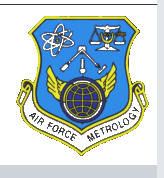

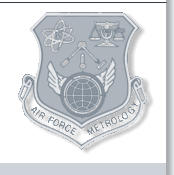
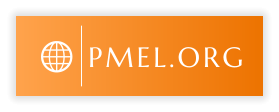
“Illegitimi Non Carborundum”
Last Updated: 11/23/2017 08:04
PMEL, Page 2
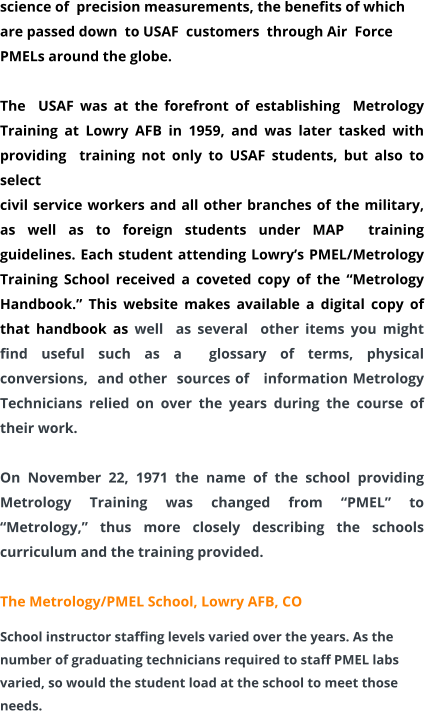
During
January
through
June
of
1961,
for
example,
course
ALR32470
reached
a
peak
training
load
of
285
students.
During
the
period
of
July
-
December
of
1965
the
PMEL
Branch
had
a
shortage
of
approximately
ten
qualified
instructor
personnel.
The
increase
in
duration
of
the
ALR32430
course
increased
the
qualified
instructor
shortage
to
36.
Increases
of
qualified
instructors
available
to
Special
Training
courses
increased
the
shortage
to
48,
while
Navy
training
commitments
increased
the
shortage
to
70.
The
number
of
training
courses
supported
by
the
school,
course
durations,
and
the
number
of
required
graduating
students
each
year
drove
the
PMEL
school’s
staffing
levels.
Additional
requirements
materialized
as
a
result
of
instructors
being
assigned
writing/authoring
duties…someone
had
to
write
the
course
material
as
well
as
material
for
the
OJT
packages
used
in
the
field
to
further
a
Metrology
technician’s
knowledge for advancement to the next skill level.
PMEL/Metrology
Instructors
consisted
of
individuals
who
volunteered
for
the
duty.
While
a
very
few
may
have
entered
the
instructor’s
rolls
upon
graduating
from
the
basic
coarse,
the
majority
would
have
served
several
years
in
the
field
working
on
an
Air
Base
in
a
PME
Lab
prior
to
becoming an instructor.
Before
an
instructor
volunteer
would
be
assigned
classroom
duties,
they
would
have
to
have
completed
several
pre-
requisite
(
Continued
)



“Illegitimi Non
Carborundum”
PMEL, Page 2
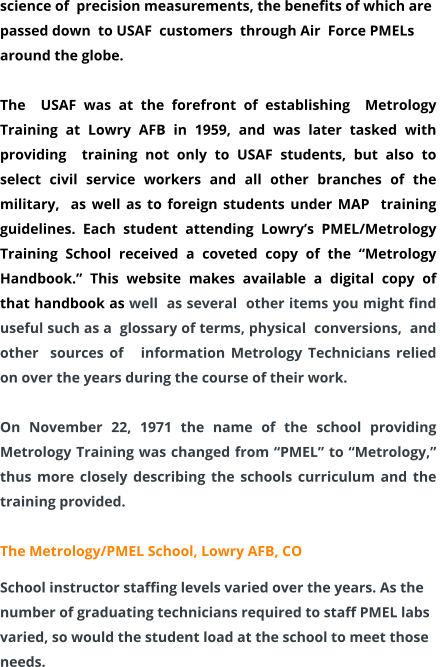
During
January
through
June
of
1961,
for
example,
course
ALR32470
reached
a
peak
training
load
of
285
students.
During
the
period
of
July
-
December
of
1965
the
PMEL
Branch
had
a
shortage
of
approximately
ten
qualified
instructor
personnel.
The
increase
in
duration
of
the
ALR32430
course
increased
the
qualified
instructor
shortage
to
36.
Increases
of
qualified
instructors
available
to
Special
Training
courses
increased
the
shortage
to
48,
while
Navy
training
commitments
increased
the
shortage
to
70.
The
number
of
training
courses
supported
by
the
school,
course
durations,
and
the
number
of
required
graduating
students
each
year
drove
the
PMEL
school’s
staffing
levels.
Additional
requirements
materialized
as
a
result
of
instructors
being
assigned
writing/authoring
duties…someone
had
to
write
the
course
material
as
well
as
material
for
the
OJT
packages
used
in
the
field
to
further
a
Metrology
technician’s
knowledge
for
advancement
to
the
next skill level.
PMEL/Metrology
Instructors
consisted
of
individuals
who
volunteered
for
the
duty.
While
a
very
few
may
have
entered
the
instructor’s
rolls
upon
graduating
from
the
basic
coarse,
the
majority
would
have
served
several
years
in
the
field
working
on
an
Air
Base
in
a
PME
Lab
prior
to
becoming
an
instructor.
Before
an
instructor
volunteer
would
be
assigned
classroom
duties,
they
would
have
to
have
completed
several
pre-
requisite
(
Continued
)

